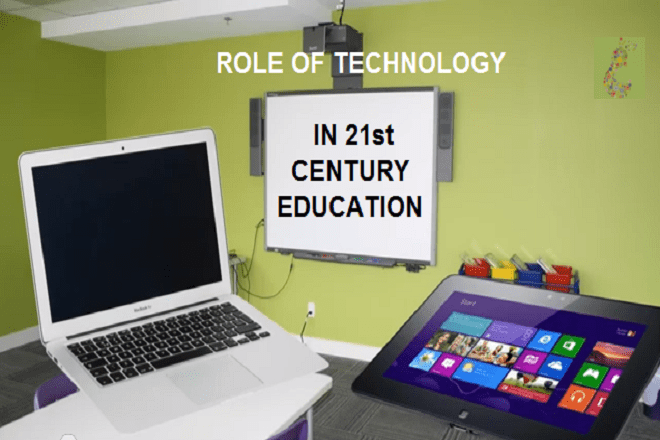Here we are to talk about technology and the role it plays in 21st century education . Technology is by far the most popular topic concerning 21st century learning and education and many of the videos on Youtube are about just that. Although some of these videos cover other ideas, technology still seems to be the central focus. So the purpose of this article is two-fold: One is to address some of the misconceptions out there about technology and also is about how to implement technology effectively and use in practical pragmatic way.
So let’s get the negatives out of the way first. Firstly I would make this point very clear that technology is not the solution to 21st century education, technology is simply a tool to aid education and learning, also technology should not be told as a separate schools subject, but as a tool, technology should be used in all classrooms. Any learning concerning technology should be based around the theme and objectives of the class.The place of technology in pedagogy is based on various factors and questions of effectiveness, time saving, increased outcomes etc.
Another issue up with technology at the moment is the poor investment in such technology without the support and consultation of EdTech staff. Schools are spending money on technology but they don’t know what it’s for how to use it. And because they spent so much money on the technology they lack in spending more on training teachers properly on how to use it. So the end result of this is that things such as interactive whiteboards end up being glorified TV sets in the classroom or simply used as regular whiteboards.
When schools cut corners in terms of spending on technology the result of this is that the things that they do buy are already outdated before they have bought them. For technology to be relevant, constant investment has to be made in that technology, its replacement and updating. I think that any investment in technology has to be made very consciously of the reasons why and how it’s going to be implemented within the school, otherwise its money down the drain. Here is where role of edtech professionals comes into play.
I would like to give an example of this, firstly one of the key aspects of 21st Century is to promote student-centered learning , however if all you invest is in the interactive whiteboards all this leads to is the exact opposite it comes back to teacher-centered learning because that interactive whiteboard becomes the teacher’s gadget and because of that it leads to more and more teacher talking time.
Although I do believe interactive whiteboards extremely useful within classrooms and within education I also think that an equal amount of investment needs to go into the other technologies for students because even though you have these touch screens that you can have multiple people using the boards at the same time you can’t have a class of thirty kids all interacting with the board directly. They need to have some alternative technology to interact together.
Quite often technology is too expensive for any school to buy, and the functionality of the technology could very limited too. And my second example of this is also my second reason why I have an issue with technology as it is used at the moment. While many teachers think 21st century education consists of using interactive games and quizzes , so it’s like taking the paper-based test and then making it digital. But all this gives teachers and students immediate feedback on student performance it just maintains the status quo on fact-based learning and completely ignores this higher-level thinking skills.
Anyway enough of the negatives, let’s move on now and think about practical and not gimmicky ways of using technology in education . As I mentioned before technology is a tool, a way for fact-based learning and allows students to do a lot of the research using the internet and various tools. And at the same time these students are learning very valuable research skills which they can transplant at high levels of education, at universities and beyond. Technology can be used to enhance critical thinking and critical literacy skills, evaluating the legitimacy and accuracy of online content is the central part of 21st century education.
It’s important for young people to understand the morals and ethics of using this online content as you would have seen in the news there are many instances of bullying online and I believe the key reason for this is the anonymity of the internet. So therefore I think that schools should teach about responsibility and accountability in the use of technology in the classroom and beyond.
So another important point is the use of technology for collaboration among students and teachers. I believe that technology and social media in education allows people to share ideas. Digital media can be kind of medium at the push of a button which can give students a voice when they wouldn’t otherwise have been heard, and at the same time as I mentioned before about critical thinking I feel that students also need to be told about how to deal with criticism, how to give criticism and how to deal with a host of other issues concerning self-esteem with online content.
I think one of the most exciting aspects of technology in education is its use for designing creativity. We can create so many different types of content written, audio , video, 2D and 3D, they can create music, they can create videos they can create photos, they can create magazines, conduct experiments and then after creating this content they can use the technology to present their ideas whether it be online or in person.
So in other words technology can be present at every stage of education process from the introduction and the research to the project making to the presentation. One of the things I want from technology is from students to be able to create very sophisticated work and by this I mean things like car design architecture, computer databases, software, games, 2-D and 3-D online animation and so on.
One last thing to consider is that technology is not just about interactive whiteboard or computers other examples include digital cameras, digital microscopes, 3-D printers as well as things like microphones and projectors as well. It’s about finding ways to use technology meaningfully, so the investment is made by schools is a worthwhile one, and it makes education more relevant to life and by making the learning more dynamic.
What are your views on how to use technology effectively in education?
Check out More from Insights Category here.



